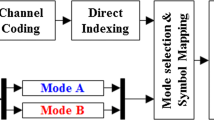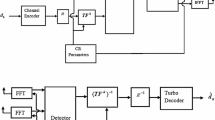Abstract
The goal of fourth generation (4G) mobile communications system is to seamlessly integrate a wide variety of communication services such as high speed data, video and multimedia traffic as well as voice signals. One of the promising approaches in 4G is the Adaptive Orthogonal Frequency Division Multiplexing (AOFDM) technique. In Multiple Input Multiple Output (MIMO)-OFDM, adaptive transmission scheme is employed according to channel fading conditions in OFDM to improve the performance. In this paper, adaptive modulation is only considered. To further enhance the system performance, convolutional coding can be employed to the OFDM system. The obtained results show that significant improvement in bit error rate and average spectrum efficiency can be achieved demonstrating the superiority of the adaptive modulation schemes compared to fixed transmission schemes.












Similar content being viewed by others
References
H. Yang, A road to future broadband wireless access: MIMO-OFDM based air interface, IEEE Communications Magazine, Vol. 43, No. 1, pp. 53–60, 2005.
V. Balakrishna, and Vidhyacharan Bhaskar, “Performance analysis over slowly fading multiple input multiple output channels using quantized and erroneous feedback,” IET Communications, vol. 6, no. 11, pp. 1397–1406, 2012.
S. Shyamala and Vidhyacharan Bhaskar, “Capacity of multiuser multiple input multiple output orthogonal frequency division multiplexing systems with doubly correlated channels for various fading distributions,” IET Communications, vol. 5, no. 9, pp. 1230–1236, June 2011.
P. Chan and R. Cheng, Capacity maximization for zero-forcing MIMO-OFDMA downlink systems with multiuser diversity, IEEE Transactions on Wireless Communications, Vol. 6, No. 5, pp. 1880–1889, 2007.
Y. Zhang and K. Letaief, An efficient resource-allocation scheme for spatial multiuser access in MIMO/OFDM systems, IEEE Transactions on Communications, Vol. 53, No. 1, pp. 107–116, 2005.
Sarma Sandeep Jayakrishnan, and Vidhyacharan Bhaskar, “Performance analysis of MIMO-OFDM in various outdoor fading environments,” International Journal of Electronics and Communications, vol. 66, no. 10, pp. 22–28, Jan. 2012.
Raj, U., and Bhaskar, V., “Performance analysis of scheduling schemes for MIMO-OSFBC-OFDM system in α − μ fading channel scenarios,” International Conference on Communications and Signal Processing (ICCSP), DOI: 10.1109/iccsp.2013.6577033, pp. 144–148, 2013.
Vidhyacharan Bhaskar, “Novel Closed-form expressions for Ergodic capacity of MIMO-OSFBC-OFDM systems over Channel adaptation policies,” Wireless Personal Communications, DOI: 10.1007/s11277-013-1537-6, vol. 77, no. 2, pp. 811–822, July 2014.
K. M. Hadi, R. Tripathi, and K. Kant, “Performance of adaptive modulation in a multipath fading channel,” 8 th International Conference on Advanced Communication Technology (ICACT), Phoenix Park, Korea, vol. 2, pp. 1277–1282, Feb. 2006.
M. Torabi, S. Aissa and M. Soleymani, On the BER performance of space-frequency block coded OFDM systems in fading MIMO channels, IEEE Transactions on Wireless Communications, Vol. 6, No. 4, pp. 1366–1373, 2007.
J. Chen and T. Pratt, “Energy efficiency of adaptive transmission for MIMO-OFDM systems over polarization-sensitive channels”, 2014 National Wireless Research Collaboration Symposium (NWRCS), IdahoUSA, 2014. pp. 127–132.
P. Xia, S. Zhou and G. B. Giannakis, Adaptive MIMO-OFDM based on partial channel state information, IEEE Transactions on Signal Processing, Vol. 52, No. 1, pp. 202–213, 2004.
N. Peram and V. Bhaskar, Performance modelling of finite-state Markov chains for Nakagami-q and α − μ distributions over adaptive modulation and coding schemes, AeUe International Journal of Electronics and Communications, Vol. 67, No. 1, pp. 64–71, 2013.
S. Krithiga, and Vidhyacharan Bhaskar, “Performance of threshold conditions over independent and non-identically distributed α − μ fading channels over multiple input multiple output orthogonal space-time block coding systems,” IET Communications, vol. 8, no. 16, pp. 2891–2899, Nov. 2014.
S. Sampei and H. Harada, System Design Issues and Performance Evaluation for Adaptive Modulation in New Wireless Access Systems, Proceedings of the IEEE, Vol. 95, No. 12, pp. 2456–2471, 2007.
T. S. Rappaport, Wireless Communications, Principles and Practice, vol. 2nd, Prentice Hall Inc.NJ, USA, 2001.
T. M. Duman, and A. Ghrayeb, Coding for MIMO Communication Systems, John Wiley & Sons, Ltd., West Sussex PO19 8SQ, UK, 2007.
I. S. Gradshteyn and I. M. Ryzhik, Table of Integrals, Series and Products, vol. 7th, Academic PressBurlington, MA, USA, 2007.
Author information
Authors and Affiliations
Corresponding author
Rights and permissions
About this article
Cite this article
Bhaskar, V., Reddy, K.N. Adaptive Transmission in a MIMO-OFDM System in Nakagami-m Fading Channels. Int J Wireless Inf Networks 22, 285–293 (2015). https://doi.org/10.1007/s10776-015-0280-1
Received:
Accepted:
Published:
Issue Date:
DOI: https://doi.org/10.1007/s10776-015-0280-1




